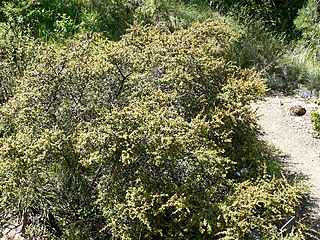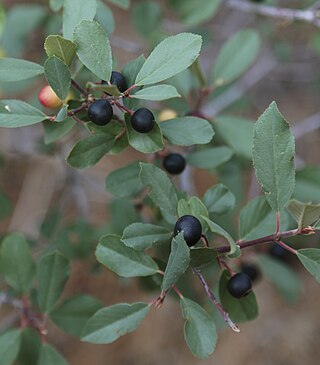
Ceanothus is a genus of about 50–60 species of nitrogen-fixing shrubs and small trees in the buckthorn family (Rhamnaceae). Common names for members of this genus are buckbrush, California lilac, soap bush, or just ceanothus. "Ceanothus" comes from Ancient Greek: κεάνωθος (keanōthos), which was applied by Theophrastus to an Old World plant believed to be Cirsium arvense.

Rhamnus is a genus of about 140 accepted species of shrubs or small trees, commonly known as buckthorns, in the family Rhamnaceae. Its species range from 1 to 10 m tall and are native mainly in east Asia and North America, but found throughout the temperate and subtropical Northern Hemisphere, and also more locally in the subtropical Southern Hemisphere in parts of Africa and South America. One species, the common buckthorn, is able to flourish as an invasive plant in parts of Canada and the U.S., where it has become naturalized.

The Northern California coastal forests are a temperate coniferous forests ecoregion of coastal Northern California and southwestern Oregon.

Frangula californica is a species of flowering plant in the buckthorn family native to western North America. It produces edible fruits and seeds. It is commonly known as California coffeeberry and California buckthorn.

Rhus integrifolia, also known as lemonade sumac, lemonade berry, or lemonadeberry, is a shrub to small tree. It is native to the Transverse and Peninsular Ranges and the South Coast regions of Southern California. This extends from Santa Barbara County and the Channel Islands to San Diego County and extending into north-central Pacific coastal Baja California and its offshore islands such as Cedros Island.

Baccharis pilularis, called coyote brush, chaparral broom, and bush baccharis, is a shrub in the family Asteraceae native to California, Oregon, Washington, and Baja California. There are reports of isolated populations in New Mexico, most likely introduced.

Garrya elliptica, the coast silk-tassel, silk tassel bush or wavyleaf silktassel, is a species of flowering plant in the family Garryaceae, native to the coastal ranges of California and southern Oregon. It is an erect, bushy, evergreen shrub reaching a height of 2–5 m (7–16 ft).

Prunus ilicifolia is native to the chaparral areas of coastal California, Baja California, and Baja California Sur. as well as the desert chaparral areas of the Mojave desert.

Cochemiea dioica, also called the strawberry cactus, California fishhook cactus, strawberry pincushion or fishhook cactus, is a cactus species of the genus Cochemiea. Its common name in Spanish is biznaga llavina.

Frangula alnus, commonly known as alder buckthorn, glossy buckthorn, or breaking buckthorn, is a tall deciduous shrub in the family Rhamnaceae. Unlike other "buckthorns", alder buckthorn does not have thorns. It is native to Europe, northernmost Africa, and western Asia, from Ireland and Great Britain north to the 68th parallel in Scandinavia, east to central Siberia and Xinjiang in western China, and south to northern Morocco, Turkey, and the Alborz in Iran and the Caucasus Mountains; in the northwest of its range, it is rare and scattered. It is also introduced and naturalised in eastern North America.

Rhamnus crocea, the spiny redberry, is a species of plant in the family Rhamnaceae. It is native from California to northern Mexico. As of March 2024, five subspecies are recognized.
The Red Hills are a mountain range in Tuolumne County, California. Elevations within the Red Hills vary between 750 and 1,750 feet above sea level. Slopes of the hills themselves vary from about 30% to 75%.

Frangula caroliniana, commonly called the Carolina buckthorn, is a deciduous upright shrub or small tree native to the southeastern, south-central, and mid-western parts of the United States, from Texas east to Florida and north as far as Maryland, Ohio, Missouri, and Oklahoma. There is also an isolated population in the State of Nuevo León in northeastern Mexico. It is found in a wide variety of habitats, including barrens, forests, and limestone bluffs.

Rhamnus alnifolia is a species of flowering plant in the buckthorn family known by the common names alderleaf buckthorn, or alder buckthorn. Unlike other "buckthorns", this alder buckthorn does not have thorns. It is native to North America, where it is known mainly from the southern half of Canada and the northern half of the United States and California. It can be found in forested habitat.
Rhamnus crocea subsp. pirifolia, synonym Rhamnus pirifolia, is a subspecies of tree and shrub in the buckthorn family known by the common name island redberry. It is an island endemic which is known only from the Channel Islands of California and Guadalupe Island off Baja California. Its habitat consists of coastal sage scrub and chaparral.

Frangula rubra is a species of flowering plant in the buckthorn family known by the common names red buckthorn and Sierra coffeeberry.

Rhamnus lycioides, the black hawthorn, European buckthorn, or Mediterranean buckthorn, is a shrub up to about 1 metre tall in the buckthorn family, Rhamnaceae. It is found in the Mediterranean region, in southern Europe and northern Africa. Its scientific name lycioides refers to its resemblance to the botanical genus Lycium.

Rhamnus alaternus is a species of flowering plant in the buckthorn family Rhamnaceae, known by the common names Italian buckthorn or Mediterranean buckthorn. It is a hardy medium-sized evergreen shrub with fragrant flowers.

Garrya wrightii is a species of flowering plant in the family Garryaceae known by the common names Wright's silktassel, quinine-bush, coffee berry, bearberry, feverbush, and grayleaf dogwood.

















